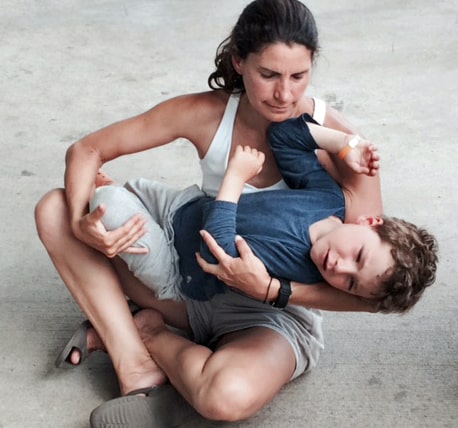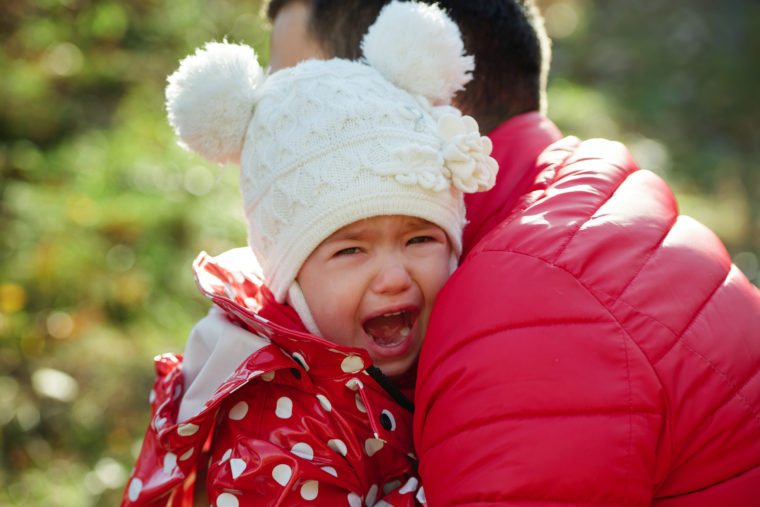 Our children can pick really inconvenient times to melt down; they throw themselves on the floor in a flood of tears and refuse to go anywhere! They frustrate us when we are trying to get out the door, embarrass us in the grocery store, or suddenly make things awkward at Grandma’s house. Rarely do we busy parents feel like we have the time and space to listen. But I’m happy to say that having a greater understanding of the mechanisms behind why tears and tantrums can be beneficial has allowed my empathy, connection and warmth to flow more easily when my children are upset. It has allowed me to understand at a fundamental level how we build our children’s intelligence when we offer connection.
Our children can pick really inconvenient times to melt down; they throw themselves on the floor in a flood of tears and refuse to go anywhere! They frustrate us when we are trying to get out the door, embarrass us in the grocery store, or suddenly make things awkward at Grandma’s house. Rarely do we busy parents feel like we have the time and space to listen. But I’m happy to say that having a greater understanding of the mechanisms behind why tears and tantrums can be beneficial has allowed my empathy, connection and warmth to flow more easily when my children are upset. It has allowed me to understand at a fundamental level how we build our children’s intelligence when we offer connection.
Why tears are helpful
The underlying principle of the tool of Staylistening is that crying is a natural recovery process. Allowing our children to cry and tantrum can be a powerful way to heal hurts, restore good judgment and bring closeness to the parent-child relationship (Patty Wipfler, Listening to Children Booklet). Developmental psychologist and founder of Aware Parenting, Aletha Solter, writes in her book Tears and Tantrums, What to do When Babies and Children Cry, that “not all crying is an indication of an immediate need or want. Much of it is a natural stress-release mechanism that allows children to heal from the effects of frightening or frustrating experiences that have occurred previously.” In other words, babies and children do cry to communicate unmet needs, however it’s not the only reason — they also cry to release stress and strain resulting from physical or emotional tension.
Crying can also bring us closer to those around us. It is an important communication mechanism for building a strong attachment and understanding between children and parents (Solter, 2009; Nelson, 2005). This is particularly evident when those close to us can be supportive when we cry, allowing the healing benefits to kick in (Bylsma, 2011).
What happens when we listen?
 Listening to tears helps children feel more relaxed and restores their sense of equilibrium. Neuroscience can help explain the mechanisms behind Staylistening. The limbic system, the social and emotional hub of the brain, fully developed at birth, is wired for emotional connection. In fact, humans are biologically programmed to be in close proximity to each other as a way of regulating and aligning our inner emotional and physical states (Lewis, Amini & Lannon, 2000; Graham, 2008).
Listening to tears helps children feel more relaxed and restores their sense of equilibrium. Neuroscience can help explain the mechanisms behind Staylistening. The limbic system, the social and emotional hub of the brain, fully developed at birth, is wired for emotional connection. In fact, humans are biologically programmed to be in close proximity to each other as a way of regulating and aligning our inner emotional and physical states (Lewis, Amini & Lannon, 2000; Graham, 2008).
The limbic system is always tuning in to the surroundings, looking for connections. When the limbic system senses connection and safety, it can coordinate other functions of the brain, including the higher processing centres like the prefrontal cortex. This is the hub of reasoning, logic, and good judgement. When the limbic system cannot sense connection, these functions are limited. For example, when you have repeatedly asked your four-year-old to stop pulling the cat’s tail, and he is not listening, his limbic system may be so full of emotional tension from small hurts that have built up during the day that he cannot remember that it’s not okay to hurt the cat, nor can he hear what you are saying. His higher processing centres of reasoning, memory and judgement are impaired in that moment.
When an upset child is listened to with warmth and connection, the limbic system senses this, and the child can use this limbic connection to steady and release the emotions that flood the system (Lewis, Amini & Lannon, 2000). When emotions are acknowledged and validated, it allows the healing process to kick in. First there is the joining and attunement to the other, “I hear you, I see you are upset,” then the offering of connection and holding the space, “You are safe now, I know you can get through this. You are loved.” This process actually allows new circuitry within the brain to be built, and recovery to take place. Recent findings in interpersonal neurobiology are leading toward the perspective that we are not entirely separate beings; our minds are connected and we can play a powerful role in healing through tuning in to each other (Siegel, 2010).
For children, the benefits of crying do not follow from crying that’s done alone. Research has shown that babies left to “cry it out” or children crying in isolation do not show the healing benefits of Staylistening, or crying with an empathic listener. Babies left to cry alone do not release the stress hormones from their tears, in fact stress levels can rise (Solter, 2009). By offering warmth and understanding when our children are upset, we allow the hurt feelings to be released. The connection we give in these moments offers a different experience for the upset mind to tune into, one of safety and calm.
As Hand in Hand Parenting founder, Patty Wipfler puts it, “Feelings that are felt fully are feelings that evaporate afterwards.”
Why is it so hard to let our children cry?
 Feeling unable to stop or fix a crying child can be one of the hardest experiences of being a parent, as our children’s tears and tantrums provoke intense feelings in us. Solter (2009) reviews numerous studies that have shown that crying has been linked to parents feeling exasperated, anxious, depressed, resentful and has even led to child abuse. The intense feelings that arise in us when our children cry or tantrum can be explained by our own unmet needs for emotional release. Often our own memories are triggered and we cannot separate the past from present, leading us to “lose it” with our children; we are unable to respond in a productive way (Siegel & Hartzell, 2004).
Feeling unable to stop or fix a crying child can be one of the hardest experiences of being a parent, as our children’s tears and tantrums provoke intense feelings in us. Solter (2009) reviews numerous studies that have shown that crying has been linked to parents feeling exasperated, anxious, depressed, resentful and has even led to child abuse. The intense feelings that arise in us when our children cry or tantrum can be explained by our own unmet needs for emotional release. Often our own memories are triggered and we cannot separate the past from present, leading us to “lose it” with our children; we are unable to respond in a productive way (Siegel & Hartzell, 2004).
Siegel and Hartzell further explain the importance of reflecting on and integrating these early emotional experiences so that they don’t affect our present relationships so much. Through the understanding of ourselves, we give our children the space to develop their own emotional selves.
Hand in Hand Parenting offers the tool of Listening Partnerships as a way to explore the issues that are affecting our relationship with our children. By developing trust and connection with someone else who can listen without judgement, a space is created for healing and releasing of the emotional baggage so often carried into adulthood.
A new way of thinking
![]() A new paradigm of thinking about our children and how to respond to their crying is becoming apparent. A quick overview of the popular media shows that more and more attention is being focused on the idea that children’s emotions need to be acknowledged, not shushed; that spanking leads to more damage; that the way parents and teachers respond to emotional outbursts can have far-reaching effects on learning, social and emotional regulation and integration into adulthood.
A new paradigm of thinking about our children and how to respond to their crying is becoming apparent. A quick overview of the popular media shows that more and more attention is being focused on the idea that children’s emotions need to be acknowledged, not shushed; that spanking leads to more damage; that the way parents and teachers respond to emotional outbursts can have far-reaching effects on learning, social and emotional regulation and integration into adulthood.
Responding with warmth and empathy to an upset child is not sanctioning bad behaviour, rather it is allowing the healing process to be activated. When you can be the anchor of safety in your child’s emotional storm, you will both come out the other side with a stronger and closer relationship.
Here’s how it can work
I met my son at the bus stop after school, and as we were about to drive home, my younger daughter told him that she had watched an episode of their favourite show on YouTube that day. She wasn't saying it out of spite, merely telling her brother about her day. Well, what a reaction he had! He immediately burst into angry tears, yelling at me that it wasn't fair, that he never got to do what we wanted to, that his sister did things that were more fun, and why did he have to go to school?
I could have argued back. I could have turned up the music and driven home, ignoring him. But I didn't. Because in this moment I was thankful and I welcomed his outburst. Welcomed it? Yes!
Here's why. My son had been out of sorts for a few days. He wasn't listening well to me, he was picking fights with his sister, he was not cooperating in the way he usually does. I knew he was feeling disconnected from me and himself and that these feelings were driving his unreasonable behaviour. His limbic system was filled with emotional tension. I also knew that if he allowed those feeling to come out in a cry or tantrum, then he would feel better. He would be able to think well again, and listen and cooperate more. I had tried talking to him and spending some quality time with him, but he wasn't ready to let it go. Until the moment in the car, when the trigger of his sister's announcement opened the floodgates.
He sat in his seat and kicked and cried and tensed his body in rage and frustration. Tears streamed down his face. He was hot and sweaty. It was the biggest cry he had had in a long time. I held his hand when he let me, I looked into his eyes when he searched out mine. I let him know I understood. I let him know I was there. I felt so relieved that he was letting go of the tension clouding his mind. I was so thankful I knew about the power of listening and how healing it can be.Through connection, I offered his brain a new state of mind to attune to. The limbic resonance we established allowed him to create a new pattern of thinking, one of safety and positivity, rather than being stuck in his yucky feelings.
After about five or ten minutes of intense crying and raging, my son settled into quiet sobs, and I gently reassured him I was still listening as I drove the two minutes home. When we arrived and got out of the car he melted into my arms in a huge hug. He stayed with me, then my husband for a bit before calmly going to play with his sister. He was transformed! There was a softness to him I hadn't seen in days. He was caring and flexible, and this continued into the evening routine and throughout the next few days.
This is a different way of looking at crying and tantrums. It's a way that's not always accepted in our culture. But I feel a shift in our society, as more and more people are moving towards connection and away from punishment. Not just in parenting. It always inspires me to hear of others questioning the underlying cause of people’s actions, and wanting to shift things at the emotional level, rather than handing down the traditional solution of punishment, which creates further hurt and disconnection.
We all have the in-built power to heal from difficult experiences, and we can raise the next generation with awareness of this, one “listened to” child at a time. Your job as a parent is so important.
–Lyra L’Estrange, Queensland, Australia
Bring Hand in Hand Tools to your work with children. Find out about Hand in Hand's Foundations Course for Professionals can help you create a trauma-sensitive program
Listen to this audio about how professionals use Hand in Hand's Tools in their work with children and families
Further reading from Hand in Hand
A Good Cry Can Promote Secure Attachment
The Cries that Bind: Connecting With Children Emotionally
References
Bylsma, L., Croon, M., Vingerhoets, A., Rottenburg, J., 2011, When and for whom does crying improve mood? A daily diary study of 1004 crying episodes. Journal of Research in Personality Volume 45, Issue 4, Pages 385–392
Graham, L., 2008, http://lindagraham-mft.net/resources/published-articles/the-neuroscience-of-attachment/
Lewis, T., Amini, F., & Lannon, R., 2000, A General Theory of Love.
Nelson, J. 2005, Seeing through tears: Crying and attachment.
Save
